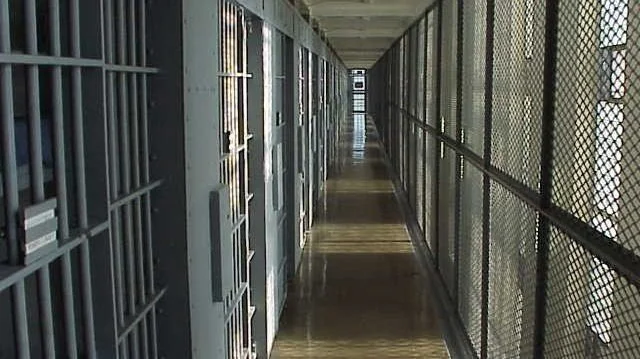More unrest at SD state penitentiary. Known by inmates as 'the hill,' it has a long history of violence, murder and riots
It’s always amazed me that the South Dakota State Penitentiary is located in the midst of Sioux Falls, the state’s largest city.
About 1,400 inmates, many with violent histories, are held within the walls of an aging prison that looms over the city. Meanwhile, 300,000 people are living close by. It seems like a recipe for potential danger, and there have been occasions when that ended up being a deadly concoction.
There have been several riots or disturbances at the prison (an inside view from the South Dakota Dept. of Corrections website is seen above) over the years, including events in 1922, 1936, 1954, 1980, 1981, 1983, 1993 and most recently, on Wednesday and Thursday, March 27-28.
Inmates, angry over a decision to take away tablets they have been using to communicate with people outside prison walls, protested, and in at least one case, assaulted a guard. Tea Storm Chasers, a private news outlet that often scoops more established media sources, posted a live video late Thursday of inmates shouting.
On Friday, March 29, Department of Corrections Secretary Kellie Wasko, who has worked in corrections since 1999, issued a statement about the DOC trying to deal with the uprising.
“DOC staff began a thorough search of the State Penitentiary March 28th for illicit contraband in order to ensure the safety of the facility following a small group of offenders being disruptive. The search for contraband is ongoing,” it stated. “Leadership at all levels has been engaged. We are proud of the professional and dedicated staff in Sioux Falls and volunteers from other facilities that are contributing to order and security.”
In the history of the prison, it was a relatively low-key event. Over the decades, two wardens have been kidnapped, one was murdered, and a guard was killed by an inmate as well.
On Aug. 17, 1922, prison inmates tried to murder Deputy Warden Arthur Muchow, stabbing him several times and attempting to cut his throat, and kidnapped guard Martin Brusveen and Warden George T. Jameson. His son, G. Norton Jameson, later served as warden from 1938-63, the longest tenure for any prison leader. The G. Norton Jameson Annex at the penitentiary is named in his honor.
Four inmates took Warden George T. Jameson hostage, threatening to kill him if they were stopped, and fled the prison in a vehicle. They obtained another car at a nearby farm and drove to a church west of Crooks where they holed up for a day. They left Jameson there, bound but unharmed, and he was able to free himself.
The inmates were reported in numerous locations, but they were finally spotted in Murdo. Authorities set up an ambush on Aug. 25, 1922, and fired upon their car, killing Henry Coffee, a Black man who was in the front passenger seat.
The other three men, all white, were captured and returned to prison with license sentences added to their terms. They were released on Feb. 2, 1944, however.
On March 6, 1936, Warden Eugene Reiley was one of three people to die after a prison break ended in a chase that erupted into firefights between the escapees and law enforcement.
Inmate Phil Ray was killed, as was Burlan Meisel of Webster, who along with his fiancée, Freda Rausch, was in a car that the inmates attempted to hijack. Several other people were wounded.
On Oct. 11, 1954, a riot broke out because inmates were unhappy with their treatment by guards, the food they were served and the lack of adequate toilet facilities. Four prison guards were taken hostage by about 250 inmates, according to a report on the South Dakota Department of Corrections website.
Tear gas was deployed to end the riot. But inmates reportedly smashed every window in East Hall. Some drank a blend of hair tonic and/or shaving lotion and were sickened; one inmate died.
KELOLAND news reported on riots it had covered in 1980, 1983 and 1993. In 1980, about 325 inmates seized control of a cell block. They had a list of grievances, including the food they were served, the medical care they received, sanitary conditions and the amount of time they were held in their cells.
KELO anchor Steve Hemmingsen, a high-profile journalist with a strong news background and a wry sense of humor, agreed to meet with the inmates. Dexter Gronseth, then a photographer and now the station’s assignment editor, accompanied him. The two journalists went into the prison without guards escorting them to get the story, and the unrest ended without anyone being injured.
On Nov. 7, 1981, violence erupted again atop “The Hill,” as the prison is known.
According to a UPI report, “a handful of convicts armed with clubs, chains and homemade knives attacked and injured 11 guards.” Inmates Allen Quam, Ron Dennis, Wiatt Franks, William Rurup, Jody Smith and Steve Layton were scheduled to appear in court on Nov. 9, 1981, to be charged with attempted murder.
Of course, Gov. Bill Janklow responded in person. Janklow said the unrest and violence were not related to a shortage of guards.
“It’s not a staff problem at the penitentiary,” he said. “We’re dealing with criminal punks in this case and it just might be too easy a place for them.”
Janklow vowed to see the inmates slapped with “long, long sentences.”
There was another riot in May 1993, with more than 200 inmates seizing control of a section of the prison and lighting fires. Two guards were injured when they were beaten with a softball bat during a confrontation with inmates on a recreation yard, and they were taken to a hospital.
Inmates, many of them who had been drinking alcohol fermented inside the prison, demanded a staff member be fired and that disciplinary methods be altered. Inmate Harold Hill, a star on the 1973 state champion Huron High School boys basketball team, was the spokesman for the protestors, and for a couple days, he was back in the spotlight.
This riot was covered live on TV and I recall watching it play out. Once again, KELO was brought in, and its camera recorded the inmates surrendering, as they wanted to ensure they would not be attacked by the guards.
Another tragedy occurred on April 12, 2011, when prison guard Ronald “R.J.” Johnson was murdered by two inmates in an escape attempt.
It was Johnson’s 63rd birthday, and he was supposed to have the day off, but he was called into work. Johnson was close to retirement, but he was a loyal employee who came to the prison for what turned out to be his final shift.
Rodney Berget, already serving a life sentence for attempted murder and kidnapping, and fellow inmate Eric Robert, who was serving 80 years for a kidnapping conviction, beat Johnson over the head with a pipe and covered his head with plastic wrap.
Berget had attempted four escapes previously, and Robert had tried to escape once. Robert donned Johnson’s uniform and Berget hid in a box that Robert pushed in a handcart. They made it through one gate before a correctional officer grew suspicious.
A confrontation occurred and both men were captured. Johnson was found seriously injured and taken to Sanford Hospital, where he died that morning.
Robert told a judge his only regret was that he had not killed more guards, and vowed to kill again if given the chance. He was executed on Oct. 15, 2012.
On Oct. 29, 2018, Berget was executed via a lethal injection. The execution was delayed while the U.S. Supreme Court briefly considered the case.
Berget, whose brother Roger was executed in Oklahoma in 2000 for killing a man while stealing his car, offered a joke in the minutes before his death.
“Sorry for the delay, I got caught in traffic,” he said.
Witnesses, including Johnson’s widow, were not amused.
I covered another horrific case for The Mitchell Daily Republic, when inmate James McVay, high on a mixture of cough syrup and alcohol, walked away from the prison and murdered 75-year-old Maybelle Schein on July 1, 2011.
Schein had worked as a nursing instructor in Mitchell and Sioux Falls before spending 34 years working for the Centers for Disease Control (CDC), going to many countries across the world in dangerous settings. She was honored by Dakota Wesleyan University for her work and had settled into a comfortable life in Sioux Falls, working at Dougherty Hospice House in Sioux Falls.
Schein was asleep in her home, with her garage door partially open to allow her dog to go outside. McVay, who had a lengthy history of mental health issues and had walked away from minimum-security custody settings before, entered her house by sliding under the garage door.
He found her keys and purse and could have fled with her car. But he said he watched Schein sleep for a whole before attacking her, asked Satan for strength, and then stabbed her nine times, killing her.
He then fled, determined to drive to Washington, D.C., where he wanted to try to assassinate President Barack Obama. He was caught in Wisconsin and returned to South Dakota.
McVay was sentenced to death, but he committed suicide on Sept. 2, 2014, hanging himself in his cell with bedsheets.
The old prison, which was opened in 1881, has seen many additions and improvements over the decades. But it is still an ominous, cramped, spooky place. I have visited it several times, and have often driven past it.
Its days are apparently numbered, with the state budgeting $383 million to build a new men’s prison in rural Lincoln County.
Many locals are less than thrilled with the idea of hundreds of inmates being housed near them. With the long history of violence, riots and unrest, you can’t really blame them, either.
We need to have prisons, of course, although some inmates would likely be better served in another facility. But for the most dangerous types, the kind who have killed and attacked others, there is no other option.
Where to build it? How can we keep people nearby — and the men and women who work there — safe? That’s a question that has yet to be adequately addressed, as history has proven. Wasko told legislators that in January.
“We have had staff that have said that they don’t feel safe,” she said. “I’ll be honest with you, I’ve been doing prisons for a long time, and on The Hill, I don’t feel safe.”
Tom Lawrence has written for several newspapers and websites in South Dakota and other states and contributed to The New York Times, NPR, The Telegraph, The Daily Beast and other media outlets. Do not republish without permission.







